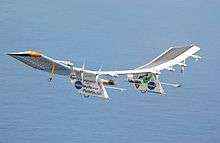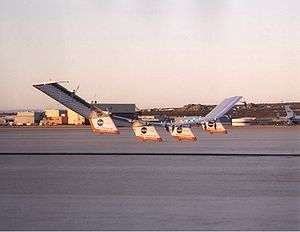Atmospheric satellite
.ogg.jpg)
An atmospheric satellite (United States usage, abbreviated atmosat) or pseudo-satellite (British usage) is an aircraft that operates in the atmosphere at high altitudes for extended periods of time, in order to provide services conventionally provided by an artificial satellite orbiting in space.
Atmospheric satellites remain aloft through atmospheric lift, either aerostatic (e.g., balloons) or aerodynamic (e.g., airplanes). By contrast, conventional satellites in Earth orbit operate in the vacuum of space and remain in flight through centrifugal force derived from their orbital speed.
To date, all atmosats have been unmanned aerial vehicles (UAVs).
Design principles
Overview
An atmosat remains aloft through atmospheric lift, in contrast to an artificial satellite in Earth orbit which remains aloft through centrifugal force derived from its high orbital speed. Because of this high speed a satellite must operate in the vacuum of space, is expensive to build and launch, and its path is inflexible once launched. Atmospheric satellites fly much slower and are intended to provide a range of services more economically and with more versatility than current low Earth orbit satellites.[1]
Operating altitudes are expected to be in the tropopause—at approximately 65,000 feet—where winds are generally less than 5 knots and clouds do not block sunlight.[2] It is desirable in the United States to operate above 60,000 feet, above which the Federal Aviation Administration does not regulate the airspace.[2]
There are two classes of atmosat, respectively gaining their lift through either aerostatic (e.g., balloons) or aerodynamic (e.g., airplanes) forces. In order to remain aloft for long periods, the NASA and Titan Aerospace designs use propeller-driven electric airplanes powered by solar cells, in contrast to Google's Project Loon which envisions using helium-filled high-altitude balloons.[1][3]
Airplanes
To enable night time operation and ensure endurance through consecutive 24-hour day/night cycles, in daylight hours solar panels charge batteries[2] or fuel cells[4] which subsequently power the vehicle during hours of darkness. An atmospheric satellite may initially ascend at night under battery power, and reach altitude soon after dawn to allow solar panels to take advantage of a full day's sunlight.[1]
Facebook's UAV-based Aquila system uses laser communication technology to provide Internet communication among UAVs, and also between UAVs and ground stations that in turn connect to rural areas.[5] The Aquila UAV involves a carbon fiber, solar-powered flying wing design about the size of a passenger jet.[5][6] Aquila's first successful test flight took place on June 28, 2016.[6] The Aquila is designed and manufactured by the UK company Ascenta.[7]
Balloons

One current project is the Google's Project Loon, which envisions using helium-filled high-altitude balloons.
Applications
Proposed applications for atmosats include border security, maritime traffic monitoring, anti-piracy operations, disaster response, agricultural observation, atmospheric observation, weather monitoring, communications relay, oceanographic research, Earth imaging and telecommunications.[2] Facebook is reportedly envisioning providing Internet access to the African continent with a fleet of 11,000 vehicles.[1]
History
The initial goals under the NASA's Environmental Research Aircraft and Sensor Technology (ERAST) project were to demonstrate sustained flight at an altitude near 100,000 feet and flying non-stop for at least 24 hours, including at least 14 hours above 50,000 feet.[4] The early development path of atmospheric satellites included the NASA Pathfinder (exceeding 50,000 feet in 1995), the Pathfinder Plus (80,000 feet in 1998), and the NASA Centurion which was modified into a prototype configuration for the NASA Helios (96,000 feet in 2001).[4] An Airbus/Qinetiq Zephyr flew for 14 days in the summer of 2010, and in 2014 a Zephyr 7 stayed up for 11 days in the short days of winter whilst carrying a small payload for the British Ministry of Defence.[8] In 2014, the development goals of Titan Aerospace, purchased by Google,[9] included operation at altitudes exceeding 60,000 feet for as long as five years.[1]
See also
| Wikimedia Commons has media related to Atmospheric satellites. |
References
- 1 2 3 4 5 Perez, Sarah; Constine, Josh (March 4, 2014). "Facebook In Talks To Acquire Drone Maker Titan Aerospace". TechCrunch. Archived from the original on March 4, 2014.
- 1 2 3 4 Dillow, Clay (August 23, 2013). "The drone that may never have to land". Fortune (CNN). Archived from the original on March 9, 2014.
- ↑ Google Buys Solar-Powered Drones to Expand Internet Access, Accessed April 22, 2014
- 1 2 3 "NASA Armstrong Fact Sheet: Helios Prototype". NASA. February 28, 2014. Archived from the original on March 9, 2014.
- 1 2 Perry, Tekla S. (April 13, 2016). "Facebook's Aquila Drone Creates a Laser-net In the Sky". IEEE Spectrum. Archived from the original on April 14, 2016. ● Gershgorn, Dave (February 23, 2016). "Facebook's Enormous Internet Drone is Almost Ready for Primetime". Popular Science. Archived from the original on April 19, 2016.
- 1 2 Metz, Cade (21 July 2016). "Facebook's Giant Internet-Beaming Drone Finally Takes Flight". Wired. Retrieved 2016-07-21.
- ↑ Rory Cellan-Jones; Facebook's drones - made in Britain, BBC, 21 July 2016. (Retrieved 24 July 2016).
- ↑ Tovey, Alan (31 August 2014). "Fly 11 days non-stop? Now that's long-haul". Daily Telegraph.
- ↑ "Google Buys High-Altitude Drone Maker". The New York Times. April 14, 2014.

